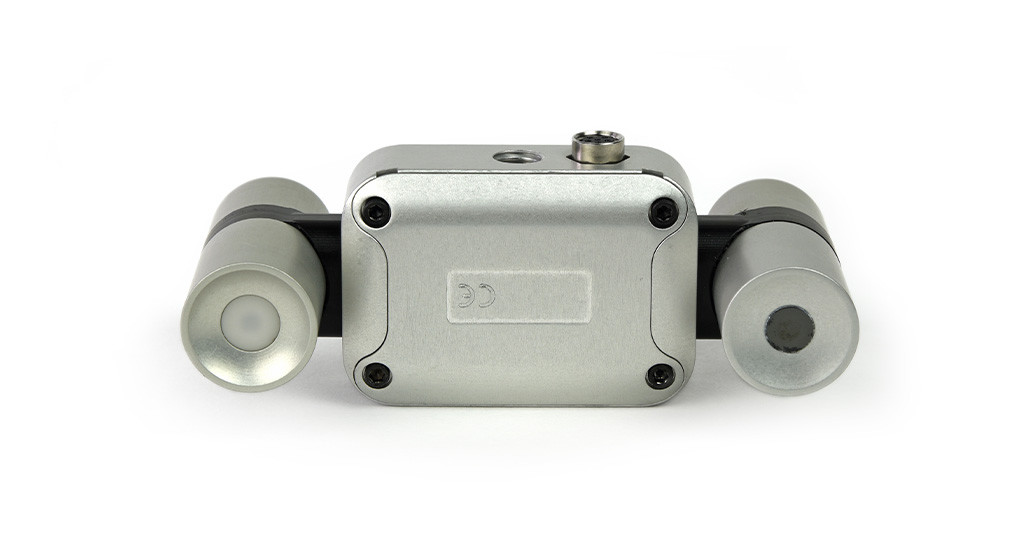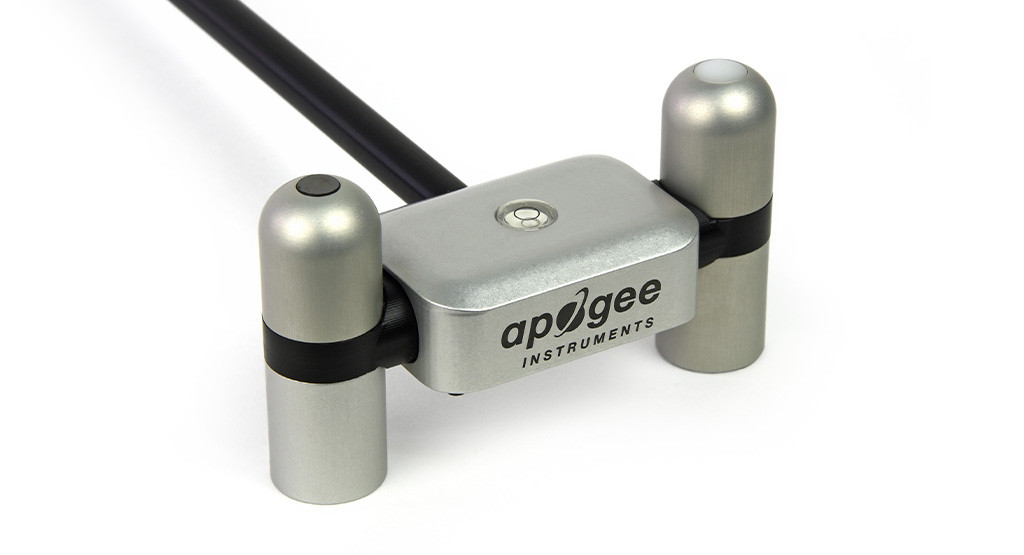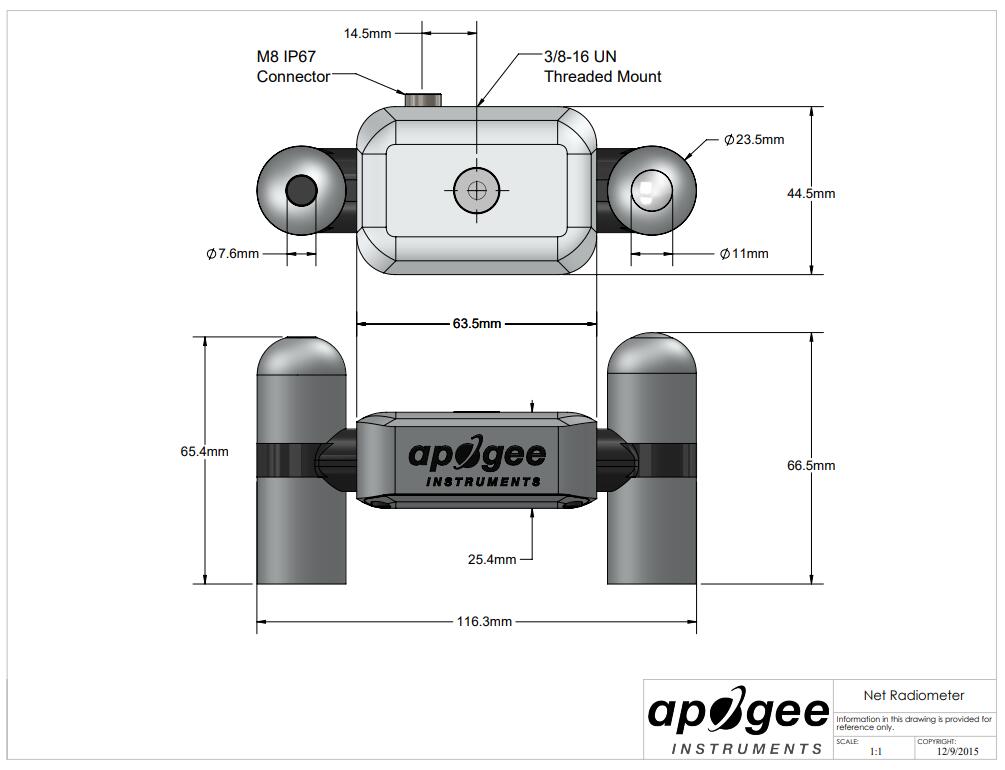Updated:2025-03-13
Views:1715
 WeChat
WeChat
 QQ
QQ
 Online Service
Online Service
 user's manual
user's manual
Apogee Instruments' new four-component net radiometer provides individual measurement of net radiation components. The sensor features a Modbus RS-232 or RS-485 output, eliminating the need for multiple analog channels to measure the individual components of net radiation. The net radiometer comes as a complete package that includes net radiometer, mounting rod, pigtail lead cable for datalogger interface, and carrying case.


Apogee net radiometers feature onboard A/D conversion and Modbus output to eliminate the requirement of multiple analog datalogger channels.
Four-component Net RadiometerAn upward-looking and downward-looking pyranometer, and an upward-looking and downward-looking pyrgeometer provide separate measurements of the four components of net radiation.
Individually Heated RadiometersEach radiometer includes an individual heater to increase accuracy by minimizing the influence of dew/frost on the filter.
Compact and Light WeightDesigned to be light weight and small in size to facilitate easy mounting.

| Input Voltage Range | 5.5 to 24 V DC (heaters are optimized to run at 12 V DC) |
| Output | RS-232 or RS-485 |
| Current Draw (12 V DC Supply Voltage) | Heaters on: 72 mA; Heaters off: 13.5 mA |
| Response Time | It takes 750 ms to digitize all detector signals |
| Heaters (sensors individually heated) | 62 mA current drain and 740 mW power requirement at 12 V DC |
| Operating Environment | -50 to 80 C; 0 to 100 % relative humidity |
| Dimensions | 116 mm length, 45 mm width, 66 mm height |
| Mass | 320 g (with mounting rod and 5 m of lead wire) |
| Cable | M8 connector (IP68 rating) to interface to sensor housing, 5 m of four conductor shielded, twisted-pair wire in a santoprene rubber jacket with pigtail lead wires |
| Manufactured | Made in the USA |
| Pyrgeometer | Specifications |
| Pyrgeometer Sensitivity | 0.12 mV per W mˉ² (variable from sensor to sensor, typical value listed) |
| Pyrgeometer Calibration Factor (Reciprocal of Sensitivity) | 8.5 W mˉ² (variable from sensor to sensor, typical value listed) |
| Pyrgeometer Calibration Uncertainty | ± 5 % |
| Pyrgeometer Output Ranges | -24 to 24 mV |
| Pyrgeometer Measurement Range | -200 to 200 W mˉ² (net longwave irradiance) |
| Pyrgeometer Measurement Repeatability | Less than 1 % |
| Pyrgeometer Long-term Drift | Less than 2 % change in sensitivity per year |
| Pyrgeometer Non-linearity | Less than 1 % |
| Pyrgeometer Detector Response Time | Less than 0.5 s |
| Pyrgeometer Field of View | 150˚ |
| Pyrgeometer Spectral Range | 5 to 30 µm |
| Pyrgeometer Temperature Response | Less than 5 % from -15 to 45 C |
| Pyrgeometer Window Heating Offset | Less than 10 W mˉ² |
| Pyrgeometer Zero Offset B | Less than 5 W mˉ² |
| Pyrgeometer Tilt Error | Less than 0.5 % |
| Pyrgeometer Uncertainty in Daily Total | ± 5 % |
| Pyrgeometer Temperature Sensor | 30 kΩ thermistor, ± 1 C tolerance at 25 C |
| Pyrgeometer Output from Thermistor | 0 to 2500 mV (typical, other voltages can be used) |
| Pyrgeometer Input Voltage Requirement for Thermistor | 2500 mV excitation (typical, other voltages can be used) |
| Pyranometer | Specifications |
| Pyranometer Sensitivity | 0.045 mV per W mˉ² (upward-looking); 0.035 mV per W mˉ² (downward-looking), (variable from sensor to sensor, typical values listed) |
| Pyranometer Calibration Factor (Reciprocal of Sensitivity) | 22 W mˉ² per mV (upward-looking); 28.5 W mˉ² per mV (downward-looking) |
| Pyranometer Calibration Uncertainty | Less than 3 % at 1000 W mˉ² |
| Pyranometer Output Range | 0 to 90 mV (upward-looking); 0 to 70 mV (downward-looking) |
| Pyranometer Measurement Range | 0 to 2000 W mˉ² (net shortwave irradiance) |
| Pyranometer Measurement Repeatability | Less than 1 % |
| Pyranometer Long-term Drift | Less than 2 % per year |
| Pyranometer Non-linearity | Less than 1 % |
| Pyranometer Detector Response Time | 0.5 s |
| Pyranometer Field of View | 180˚ (upward-looking); 150˚ (downward-looking) |
| Pyranometer Spectral Range | 385 nm to 2105 nm (upward-looking); 295 nm to 2685 nm (downward-looking) |
| Pyranometer Directional (Cosine) Response | Less than 30 W mˉ² at 80˚ solar zenith (upward-looking); Less than 20 % for angles between 0 and 60˚ (downward-looking) |
| Pyranometer Temperature Response | Less than 5 % from -15 to 45 C |
| Pyranometer Zero Offset A | Less than 5 W mˉ²; Less than 10 W mˉ² (heated) |
| Pyranometer Zero Offset B | Less than 5 W mˉ² |
| Pyranometer Uncertainty in Daily Total | Less than 5 % |
Customer Service QQ
Customer Hotline:
Technical Supports